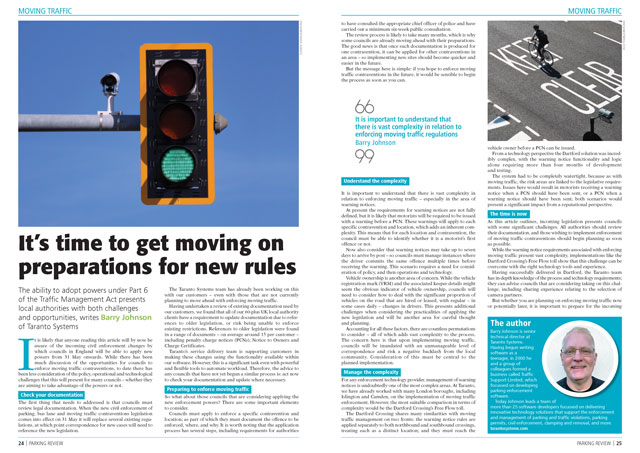By Barry Johnson from Taranto Systems
(This article first appeared in Parking Review (#358 March 2022)

It is likely that anyone reading this article will by now be aware of the incoming civil enforcement changes by which councils in England will be able to apply new powers from June onwards.
While there has been much discussion of the opportunities for councils to enforce Moving Traffic contraventions, to date there has been less consideration of the policy, operational and technological challenges that this will present for many councils – whether they are aiming to take advantage of the powers or not.
When the new Civil Enforcement of Parking, Bus Lane, and Moving Traffic Contraventions legislation comes into effect after 31 May it will replace several existing regulations, at which point correspondence for new cases will need to reference the new legislation.
The Taranto team has already been working on this with our customers – even with those that are not currently planning to move ahead with enforcing Moving Traffic.
Having undertaken a review of existing documentation used by Taranto customers, we found that all of our (60+) UK local authority clients have a requirement to update documentation due to references to older legislation, or risk being unable to enforce existing restrictions.
References to older legislation were found in a range of documents – on average around 15 per customer – including PCNs, Notice to Owners and Charge Certificates.
Taranto’s Service Delivery Team is supporting our customers in making these changes using the functionality available within the Taranto software. However, this is a significant task even with powerful and flexible tools to automate workload.
Therefore, to any councils that haven’t yet begun a similar process the message is: act now to check your documentation and update where necessary.
But what about those councils that are considering applying the new enforcement powers? There are some important elements to consider.
Councils must apply to enforce a specific contravention and location; as part of which they must document the offence to be enforced, where, and why. It is worth noting that the application process has several steps, including requirements for authorities to have consulted the appropriate Chief Officer of Police and carried out a minimum six-week public consultation.
The review process is likely to take many months, which is why some councils are already moving ahead with their preparations. The good news is that once such documentation is produced for one contravention, it can be applied for other contraventions in an area – so implementing new sites should become quicker and easier in the future.
But the message here is simple: if you hope to enforce Moving Traffic contraventions in the future, it would be sensible to begin the process as soon as you can.
It is important to understand that there is vast complexity in relation to enforcing Moving Traffic – especially in relation to warning notices.
At present the requirements for warning notices are not fully defined, but it is likely that motorists will be required to be issued with a warning before a PCN. These warnings will apply to each specific contravention and location, which adds an inherent complexity.
This means that for each location and contravention, the council must be able to identify whether it is a motorist’s first offence or not.
Now also consider that warning notices may take up to seven days to arrive by post – so councils must manage instances where the driver commits the same offence multiple times before receiving the warning. This scenario requires a need for consideration of policy, and then operations and technology.
Vehicle ownership is another area of concern. While the Vehicle Registration Mark (VRM) and the associated keeper details might seem the obvious indicator of vehicle ownership, councils will need to consider how to deal with the significant proportion of vehicles on the road that are hired or leased, with regular – in some cases daily – changes in drivers. This presents additional challenges when considering the practicalities of applying the new legislation and will be another area for careful thought and planning.
Accounting for all these factors, there are countless permutations to consider – all of which adds vast complexity to the process.
The concern here is that upon implementing Moving Traffic, councils will be inundated with an unmanageable level of correspondence and risk a negative backlash from the local community. Consideration of this must be central to the planned implementation.
For any enforcement technology provider, management of warning notices is undoubtedly one of the most complex areas.
At Taranto, we have already worked with many London boroughs, including Islington and Camden, on the implementation of Moving Traffic enforcement. However, the most suitable comparison in terms of complexity would be the Dartford Crossing’s freeflow toll.
Dartford Crossing shares similarities with Moving Traffic on two fronts: the warning notice rules are applied separately to both northbound and southbound crossings, treating each as a distinct location; and they must reach the vehicle owner before a PCN can be issued.
From a technology perspective the Dartford solution was incredibly complex, with the warning notice functionality and logic alone requiring more than four months of development and testing.
The system had to be completely watertight, because as with Moving Traffic, the risk areas are linked to the legislative requirements. Issues here would result in motorists receiving a warning notice when a PCN should have been sent, or a PCN when a warning notice should have been sent; both scenarios would present a significant impact from a reputational perspective.
As this article outlines, incoming legislation presents councils with some significant challenges. All authorities should review their documentation, and those wishing to implement enforcement of Moving Traffic contraventions should begin planning as soon as possible.
While the warning notice requirements associated with enforcing Moving Traffic present vast complexity, implementations like the Dartford Crossing’s freeflow toll show that this challenge can be overcome with the right technology tools and experience.
Having successfully delivered in Dartford, the Taranto team has in-depth knowledge of the process and technology requirements; they can advise councils that are considering taking on this challenge, including sharing experience relating to the selection of camera partners.
But whether you are planning on enforcing Moving Traffic now or potentially later, it is important to prepare for the incoming legislation without delay – June is fast approaching.
Barry Johnson is Senior Technical Director at Taranto Systems. Having begun writing software as a teenager, in 2000 he and a group of colleagues formed a business called Traffic Support Limited, which focused on developing parking enforcement software. Today Barry leads a team of more than 25 software developers focused on delivering innovative technology solutions that support the enforcement and management of parking and traffic violations, parking permits, civil enforcement, clamping and removal, and more.
